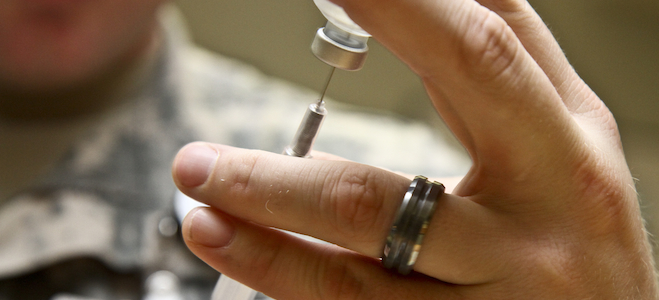Fair warning, fear-mongering and the real risk of STIs
Julia Belluz on health risks and their messaging
Share

WMD-Rs, or “weapons of mass destruction of relationships.” That’s what Dr. Des Spence, a Glasgow-based general practitioner, calls the public-health messages about sexually-transmitted infections. Over the phone from the UK, he told Science-ish that the health community has overblown the risks of contracting STIs, and that he wished they would “start conveying the facts and not fear.”
Dr. Spence would know something about the facts. In a column he wrote for British Medical Journal this year, he described the evidence behind the “tyranny of terror messages” regarding diseases such as HIV, herpes, and Chlamydia. The chance of contracting HIV from unprotected sex between low-risk people is more than a million to one, and if the virus is contracted, it’s now treatable. So, too, with herpes (“an inconvenience but no life sentence”) and Chlamydia (which does not necessarily cause infertility). “It’s up to public health to provide the facts, not to engender fear and anxiety.”
Many health-care observers would agree with the Glaswegian GP: perhaps because of a hangover from then-untreatable HIV in the 1980s, perhaps in reaction to the pseudoscience-based fears that fuel the anti-vaccination and anti-wifi movements, or perhaps because of a gap between the worlds of health research and journalism, there remains a tendency by public health toward paternalistic, fear-mongering communications of health risks about everything from STIs to pandemic threats. No doubt, these guardians of well-being at the population level, from regional to international, have a difficult task: to strike a balance between over-hyping and underselling, over-reacting and doing too little. But with the recent passage of the 10-year anniversary of SARS, and new pandemic possibilities such as H7N9 and the Coronavirus, it seems like the right time to ask: could they be doing a better job at communicating?
Dr. Rebecca Haines-Saah, a research associate at the University of British Columbia (who also happens to be a star from Degrassi High) thinks so. “We [in public health] tend to appeal to moral and ethical duties and obligations to change but that doesn’t resonate with folks,” she told Science-ish. Like Dr. Spence, she noted that a lot of public-health communications are too stigmatizing—HIV/AIDS messaging, the recent Ontario anti-smoking campaign that compares social smoking to social farting—and urged her peers to reflect on the unnecessary distress they can wreak. “We go over the top, oversell the risks, market the goriest, scariest message to be effective—but is that even ethical?”
And is it actually effective? Dr. Bruce Baskerville, a senior scientist at the University of Waterloo who studies tobacco control, pointed out there are public-health maneuvers that work without the guilt and stigma. On the anti-smoking front, one area in which evidence from around the world is unequivocal relates to the effectiveness of tobacco taxation and pricing. “If you raise the price, there’s less uptake, and more inclination for people to quit smoking.” It’s a systemic change with little overt judgement. Rethinking cigarette packaging and opening quit lines for smokers helped, too. But, he said, “The best thing is giving the public valid information, to help people make decisions.”
Part of getting better information out to the people means working more closely with journalists, explained Anne Simard, chief public affairs officer at Public Health Ontario, and having conversations, not monologues. When asked about fear-mongering from public health, she pointed out that advocacy groups—such anti-vaxxers—and the media can also be sources of anxiety, and said her agency is working on beefing up its lines of communications on social media and with journalists. “People don’t tolerate uncertainty,” she said. The key is “being transparent, being clear about what we’re doing to get towards greater certainty, and how we do that in such a way so that people come along with us.”
Indeed, being open and honest, letting the facts speak for themselves, seems to be the way forward amid public-health anxiety, such as during pandemics. There’s literature to suggest when communications lack transparency and veer too far toward advocacy—stirring a hornet’s nest of worry and alarm—they can have the opposite of the desired effect. That’s not to mention the backlash and suspicion that can arise from withholding information, as seen with China’s SARS and H7N9 communications, and Canada’s less-than-stellar record on science transparency and media engagement.
A new study in the journal EPJ Data Science looked at swine-flu vaccine messages on Twitter and found that people were more likely to share and retweet negative views. Meanwhile, those who were exposed to many positive messages often later expressed negative opinions. The lead author, Dr. Marcel Salathé of Center for Infectious Disease Dynamics at Penn State University, said this may suggest heavy-handed public-health messaging flops.
As well, he cautioned that while this was just one paper, and his peers need to test and re-test his hypothesis to see if it holds up, “What’s really fascinating about this study is the major point that we can now measure these things on such a huge scale with thousands or millions of people in real time.” Public health should examine how messages move through social networks, and recalibrate campaigns accordingly. “Ten years ago, we talked about Dr. Google and how people get health information from the Internet. Now, we have to talk about Dr. Twitter and Dr. Facebook.”
That’s a lesson for public-health communicators of every kind. In the age of Dr. Twitter, people turn to the Web and their social networks for intelligence about everything from STDs STIs to emerging pandemics. Public health ought to be there, too: this time, presenting true and timely messages, engaging in conversations, and nimbly tracking their impact in real time. No fear, just facts.
Science-ish is a joint project of Maclean’s, the Medical Post and the McMaster Health Forum. Julia Belluz is the senior editor at the Medical Post. Got a tip? Message her at [email protected] or@juliaoftoronto on Twitter.